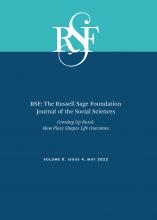Research Article
Open Access
Movin’ On Up? The Role of Growing Up Rural in Shaping Why Working-Class Men Do—and Don’t—Seek to Improve Their Labor-Market Prospects
Robert D. Francis
RSF: The Russell Sage Foundation Journal of the Social Sciences May 2022, 8 (4) 68-86; DOI: https://doi.org/10.7758/RSF.2022.8.4.03
Robert D. Francis
aAssistant professor of sociology at Whitworth University, United States

REFERENCES
- ↵
- Abraham, Katharine G., and
- Melissa S. Kearney
- ↵
- Alexander, Karl,
- Doris Entwisle, and
- Linda Olson
- ↵
- Austin, Benjamin A.,
- Edward L. Glaeser, and
- Lawrence H. Summers
- ↵
- Autor, David
- ↵
- Autor, David
- ↵
- Autor, David H., and
- David Dorn
- ↵
- Bound, John, and
- Harry J. Holzer
- ↵
- ↵
- ↵
- Butler, John Sibley, and
- Charles C. Moskos
- ↵
- ↵
- Cadena, Brian C., and
- Brian K. Kovak
- ↵
- Cajner, Tomaz,
- Leland Dod Crane,
- Ryan Decker,
- Adrian Hamins-Puertolas, and
- Christopher Johann Kurz
- ↵
- Campbell, Hugh, and
- Michael Mayerfeld Bell
- ↵
- Campbell, Hugh,
- Michael Bell, and
- Margaret Finney
- ↵
- Carr, Patrick J., and
- Maria J. Kefalas
- ↵
- Chen, Victor Tan
- ↵
- Cherlin, Andrew J
- ↵
- Cherlin, Andrew J
- ↵
- Clark, Shelley,
- Sam Harper, and
- Bruce Weber
- ↵
- Cognard-Black, Andrew J
- ↵
- Collins, Sara R.,
- Munira Z. Gunja, and
- Michelle M. Doty
- ↵
- Cottingham, Marci D
- ↵
- Cromartie, John
- ↵
- DeLuca, Stefanie,
- Susan Clampet-Lundquist, and
- Kathryn Edin
- ↵
- ↵
- ↵
- ↵
- ↵
- Doar, Robert,
- Harry J. Holzer, and
- Brent Orrell
- ↵
- The Economist
- ↵
- Edin, Kathryn, and
- Maria Kefalas
- ↵
- England, Paula
- ↵
- England, Paula
- ↵
- Finnigan, Ryan
- ↵
- Gahman, Levi
- ↵
- Ganong, Peter, and
- Daniel Shoag
- ↵
- Gatta, Mary L., and
- Patricia A. Roos
- ↵
- Glaeser, Edward L., and
- Albert Saiz
- ↵
- Glauber, Rebecca K
- ↵
- Greenstone, Michael, and
- Adam Looney
- ↵
- Hamilton, Lawrence C.,
- Leslie R. Hamilton,
- Cynthia M. Duncan, and
- Chris R. Colocousis
- ↵
- Harrington, Carol
- ↵
- Herkenhoff, Kyle F.,
- Lee E. Ohanian, and
- Edward C. Prescott
- ↵
- ↵
- Howell, David R., and
- Arne L. Kalleberg
- ↵
- ↵
- ↵
- Kalleberg, Arne L
- ↵
- Kalleberg, Arne L
- ↵
- Kane, Tim
- ↵
- ↵
- Kenway, Jane,
- Anna Kraack, and
- Anna Hickey-Moody
- ↵
- ↵
- Kleykamp, Meredith A
- ↵
- Kroft, Kory,
- Fabian Lange,
- Matthew J. Notowidigdo, and
- Lawrence F. Katz
- ↵
- Little, Jo, and
- Ruth Panelli
- ↵
- Lobao, Linda
- ↵
- Martin, Anne,
- David Lassman,
- Lekha Whittle,
- Aaron Catlin, and the National Health Expenditure Accounts Team
- ↵
- McCarthy, John F.,
- Frederic C. Blow,
- Rosalinda V. Ignacio,
- Mark A. Ilgen,
- Karen L. Austin, and
- Marcia Valenstein
- ↵
- ↵
- Miller, Claire Cain
- ↵
- Mishel, Lawrence,
- Josh Bivens,
- Elise Gould, and
- Heidi Shierholz
- ↵
- Newman, Katherine S
- ↵
- Niccolai, Ashley R.,
- Sarah Damaske, and
- Jason Park
- ↵
- O’Hare, William, and
- Bill Bishop
- ↵
- Parsons, Ryan
- ↵
- Peters, H. Elizabeth, and
- Claire Kamp M. Dush
- ↵
- ↵
- von Reichert, Christiane,
- John B. Cromartie, and
- Ryan O. Arthun
- ↵
- Reynolds, John R., and
- Chardie L. Baird
- ↵
- Ridgeway, Cecilia L., and
- Paula England
- ↵
- Rosenbaum, James E
- ↵
- Schafft, Kai A., and
- Alecia Youngblood Jackson
- ↵
- ↵
- Semuels, Alana
- ↵
- ↵
- Sherman, Jennifer, and
- Rayna Sage
- ↵
- Silva, Jennifer M
- ↵
- Silva, Jennifer M., and
- Kaisa Snellman
- ↵
- Simpson, Ruth
- ↵
- ↵
- Slack, Tim
- ↵
- Smith, Miranda N.,
- Richelle L. Winkler, and
- Kenneth M. Johnson
- ↵
- Strain, Michael R
- ↵
- Sykes, Bryan L., and
- Amy Kate Bailey
- ↵
- Tavernise, Sabrina
- ↵
- ↵
- Williams, Christine L
- ↵
- Williams, Joan C
- ↵
- Williams, Joan C
- ↵
- Woodward, Rachel
- ↵
- Wootton, Barbara H
- ↵
- Wozniak, Abigail
- ↵
- Yglesias, Matthew
In this issue
Movin’ On Up? The Role of Growing Up Rural in Shaping Why Working-Class Men Do—and Don’t—Seek to Improve Their Labor-Market Prospects
Robert D. Francis
RSF: The Russell Sage Foundation Journal of the Social Sciences May 2022, 8 (4) 68-86; DOI: 10.7758/RSF.2022.8.4.03
Jump to section
Related Articles
- No related articles found.
Cited By...
- No citing articles found.





